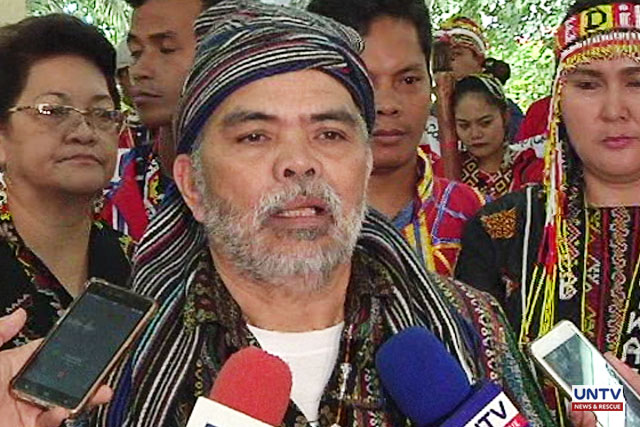
Lipatuan Joel Unad, chairman of the Mindanao Indigenous People Conference for Peace and Development
MANILA, Philippines – A total of 120 tribal chieftains from Mindanao traveled to Manila to file charges against the Communist Party of the Philippines – New People’s Army (CPP-NPA) for multiple violations of the indigenous people’s rights and other lawless acts.
Representatives from 18 major ethnic tribes in Mindanao led by Lipatuan Joel Unad, the Chairman of the Mindanao Indigenous People Conference for Peace and Development condemns the killing of 1,000 tribal leaders since the 1980s for defying orders from the communist group.
The group accused the Reds of abusing, molesting and raping their youth. The rebels were also educating their children in false ideals and curriculum not accredited by the Department of Education (DepEd).
Based on records, 70% of NPA members were recruited from the Lumads.
MANILA, Philippines – A total of 120 tribal chieftains from Mindanao traveled to Manila to file charges against the Communist Party of the Philippines – New People’s Army (CPP-NPA) for multiple violations of the indigenous people’s rights and other lawless acts.
Representatives from 18 major ethnic tribes in Mindanao led by Lipatuan Joel Unad, the Chairman of the Mindanao Indigenous People Conference for Peace and Development condemns the killing of 1,000 tribal leaders since the 1980s for defying orders from the communist group.
The group accused the Reds of abusing, molesting and raping their youth. The rebels were also educating their children in false ideals and curriculum not accredited by the Department of Education (DepEd).
Based on records, 70% of NPA members were recruited from the Lumads.
“Ipa-member ka sa CPP-NPA turuan ka kung paano kumanta ng national anthem ng mga CPP-NPA. Tinuturuan ka paano pag-dismantle ng baril. Iyon ba ang totoong pagtulong sa mga katutubo?” Unad lamented.
“Ang UP iyon pala ang institution for the indigenous people para sa lahat sana. Pero ngayon ang UP kampuhan ng mga kabataan na ginagamit ng CPP-NPA. Tinuturuan ka pala ng batas ng komunista,” he added.
Among the charges the group plans to file include multiple atrocities and extreme violence against the tribes such as burying alive, torture, death by strangling and firing squad.
The group consulted authorities from the Department of Justice (DOJ), Commission on Human Rights (CHR), the National Bureau of Investigation (NBI), the National Commission on Indigenous Peoples regarding the charges which they plan to file next week.
Unad insisted that the alleged mass protests against the government were the works of the leftists and not their group. He also countered reports on social media accusing them as fake tribal leaders.
“Sinasabi po ng social media na ang mga taong ito peke pero ito ang proseso natin kung maging peke ang mga tribal leaders na nandito hindi nakasulat sa kabundukan at saka katubigan at saka sa history yung mga pangalan nila,” he said.
Unad calls on the NPA to stop occupying their territory as they want to protect and preserve their culture and traditions.
They call on the Armed Forces of the Philippines (AFP) to help them protect their ancestral domain defense system so that economic development will also come their way such as proper education.
“Ang UP iyon pala ang institution for the indigenous people para sa lahat sana. Pero ngayon ang UP kampuhan ng mga kabataan na ginagamit ng CPP-NPA. Tinuturuan ka pala ng batas ng komunista,” he added.
Among the charges the group plans to file include multiple atrocities and extreme violence against the tribes such as burying alive, torture, death by strangling and firing squad.
The group consulted authorities from the Department of Justice (DOJ), Commission on Human Rights (CHR), the National Bureau of Investigation (NBI), the National Commission on Indigenous Peoples regarding the charges which they plan to file next week.
Unad insisted that the alleged mass protests against the government were the works of the leftists and not their group. He also countered reports on social media accusing them as fake tribal leaders.
“Sinasabi po ng social media na ang mga taong ito peke pero ito ang proseso natin kung maging peke ang mga tribal leaders na nandito hindi nakasulat sa kabundukan at saka katubigan at saka sa history yung mga pangalan nila,” he said.
Unad calls on the NPA to stop occupying their territory as they want to protect and preserve their culture and traditions.
They call on the Armed Forces of the Philippines (AFP) to help them protect their ancestral domain defense system so that economic development will also come their way such as proper education.
https://www.untvweb.com/news/120-tribal-leaders-from-mindanao-to-sue-cpp-npa-for-violating-indigenous-peoples-rights/







